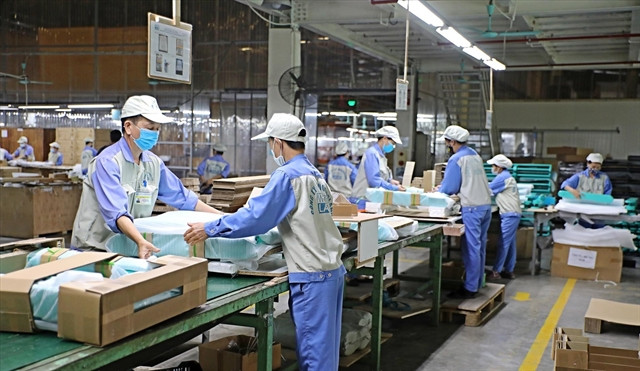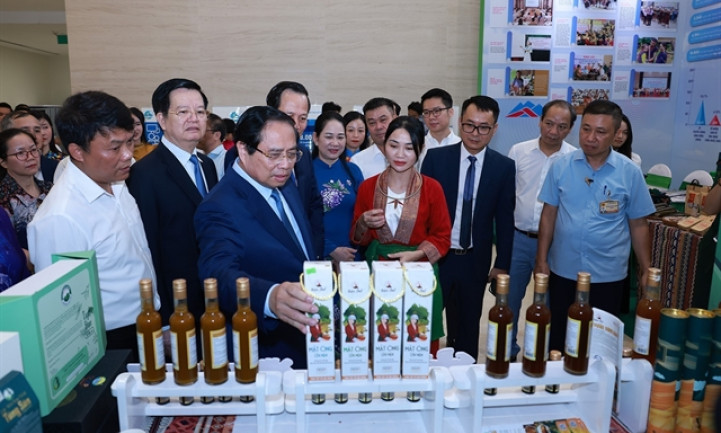Việt Nam's timber industry urged to seek new opportunities in the UK
While many products exported to the UK enjoyed strong increases owing to the UK-Việt Nam Free Trade Agreement (UKVFTA), Việt Nam’s timber industry is facing difficulty in expanding in this market that requires manufacturers and exporters to change their business strategies here.
In fact, Việt Nam’s wood industry is seeing declining sales overseas.
The export value in July was estimated at US$1.41 billion, down 5.5 per cent against June and 1.6 per cent year-on-year, according to a report of the General Department of Forestry under the Ministry of Agriculture and Rural Development (MARD).
This was the second month that the export of wood and timber products decelerated.
Earlier, figures from the General Department of Customs showed the export turnover of wood and wood products reached $1.4 billion in June, down nearly 11 per cent year-on-year. Ending July, wood and wood products were exported to rake in $10.4 billion, up just 1.3 per cent year-on-year.
Declining export orders
According to market insiders, the wood industry will face a big challenge due to a decrease in export orders in the latter half of this year.
A quick survey on 52 timber businesses conducted by the Việt Nam Timber and Forest Products Association (Vifores) in collaboration with Forest Trends showed that most companies witnessed decreasing revenues in the US, EU and UK markets.
Thirty-three out of 45 firms exporting to the US said their revenues decreased by nearly 40 per cent compared to the first months of this year. A similar trend is seen in the EU and the UK with two-thirds of the surveyed enterprises reporting revenue drops of over 41 per cent.
Moreover, about 71 per cent of businesses said that orders will continue to decrease towards the end of the year. Under the current market situation, 44 per cent of businesses expected their revenues will fall by about 44 per cent for the whole year.
According to Vifores Chairman Đỗ Xuân Lập, Việt Nam's wood industry is integrating deeply with international markets so high inflation and tightening credit policies in response to rising inflation in major markets is driving down demand for non-essential products including wood and wood products.
“High inflation in major markets such as the US, EU and UK is having a direct negative impact on the production and business activities of wood processing enterprises. They are currently facing many difficulties in terms of capital, labour costs and input materials,” Lập said at the industry meeting last week.

New opportunity in the UK
Wood and timber product export to the UK still enjoyed an increase of 14 per cent to $72 million in the first three months of 2022 but sales to this market are also declining as consumers are tightening their spending.
The June export value declined 38 per cent year-on-year to $16.3 million and in the first half, the reduction rate was 7.7 per cent at $135.5 million, data from Việt Nam's customs agency showed.
Like other parts of the world, inflation in the UK hit a 40-year high of 9.4 per cent in June as food and energy prices continued to soar, worsening the country’s historic cost-of-living crisis. The Bank of England has implemented five consecutive 25 basis point rate hikes to cool high inflation and is considering a 50 basis point hike at its August policy meeting.
According to David Hopkins, chief executive of Timber Development UK which represents all timber importers and suppliers in the country, the UK’s import of wood and wood products used to rise in the first quarter as merchants start to rebuild stocks after the winter and tend to slow down at the end of the year due to cold weather and holiday seasons.
The UK’s economy is now coping with high inflation, high interest rates and big logistics challenges due to Brexit and the Russia-Ukraine conflict which is pushing up the freight cost.
So far, Việt Nam’s predominant timber export to the UK is furniture but Hopkins sees another opportunity for Vietnamese exporters in niche areas such as plywood.
Hopkins said there was huge price inflation in timber products, but noted the demand for this commodity is still strong, especially in the sector that is expected to grow such as the construction of warehouses and lightweight industrial buildings.
“There are big opportunities for plywood from Việt Nam,” Hopkins said, noting there are not a lot of the Vietnamese products being used there, but if the construction sector can maintain positive growth, there's always demand for timber products, and “that's a good opportunity for Vietnamese exporters”.
For furniture products, Hopkins said demand is expected to decline in the next two years after a boom in housing repair and maintenance during the pandemic before it can bounce back. This trend will likely happen in the US and the EU which are also suffering from high costs of living.
The bilateral trade between Việt Nam and the UK is increasing thanks to the UKVFTA, especially tariffs on wood and timber products will be eliminated within five years (raw wood currently has a tax rate of 2-10 per cent).
However, to compete and expand sales in the UK, Hopkins suggested Vietnamese manufacturers and exporters invest in marketing and promotion to enhance awareness among UK consumers about Vietnamese products.
The concepts of legality and sustainability are important for consumers in the UK and are backed up by legislation.
"The fact that buying goods from Việt Nam has a very low risk of illegality is a really positive story," he said, emphasising that promoting this concept is very important not only in the UK but to other customers of Việt Nam around the world.






